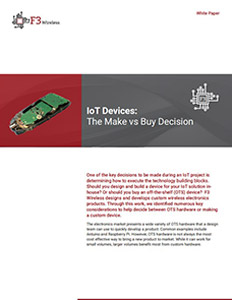White Paper: The Make vs Buy Decision
One of the key decisions to be made during an IoT project is determining how to execute the technology building blocks. Should you design and build a device for your IoT solution in-house? Or should you buy an off-the-shelf (OTS) device? F3 Wireless designs and develops custom wireless electronics products. Through this work, we identified numerous key considerations to help decide between OTS hardware or making a custom device.
The electronics market presents a wide variety of OTS hardware that a design team can use to quickly develop a product. Common examples include Arduino and Raspberry Pi. However, OTS hardware is not always the most cost-effective way to bring a new product to market. While it can work for small volumes, larger volumes benefit most from custom hardware.
Buying a Product
When choosing an OTS product that you didn’t develop, the obvious benefits include faster lead time and lower up-front investment. In this scenario, you are choosing to partner with a vendor. The more specialized the product, the greater the likelihood you can only get it from a select number of vendors, decreasing the pool of partner options and future support.
The downside of going with OTS hardware is that you sacrifice product development control; including lead time, costs, hardware revisions, size of components and ultimately ensuring the product does exactly what your use case demands. While your initial OTS hardware order is based on availability, the lead time and revision updates of future orders will be out of your control. This potentially adds significant business risk. Surprise revision changes may result in the need for product redesign, reconfiguration, and recertification. The OTS hardware may be discontinued, meaning time must be spent finding a replacement, adding engineering costs and effort. When you buy a product, you are not in control of the destiny of that product
Making a Product
Anytime you have to do something, add something, or change something to your device in order to use it, this is a “make” scenario. When you make a product, it does exactly what you need, the way you need, and it doesn’t do anything you don’t need. OTS hardware tends to be feature-rich, which means it may have a larger hardware footprint than you need or want, including unnecessary components and functionality. These can add to the unit cost of your product while adding no value to your use case.
At F3 Wireless, we specialize in making the “thing” in the Internet of Things. Our professionals can help you explore your business case needs and help you understand the trade-offs so you can choose what works best. We have options for Wi-Fi-enabled products and work with all of the major cellular module vendors. Whichever route is best for your device, F3 can take care of making it wireless.




